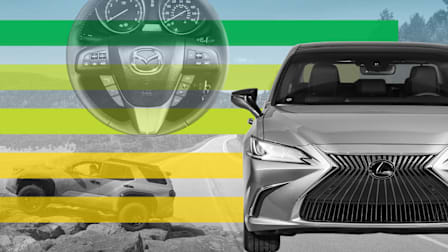How to Get a Great Deal on a Used Car
Now's the time to buy a pre-owned vehicle. CR shows you where to go and which cars to look for.

Used-car prices spiked in the supply-chain chaos that followed the pandemic, when some models actually sold for more than they cost when they were new. Now, used-car prices are down about 11 percent compared with last year, selling for just under $30,000 on average.
Meanwhile, new-car prices (average cost: $48,000) have continued to hover near record highs. Want a great deal on a car? Now is the time to buy a used one. (See our used car ratings.)
Buying From a Person
This could mean negotiating a deal with anyone, from a friend or relative to someone who has put a “for sale” sign on their car or listed it on social media or a car-sale website.
Buying From an Independent Dealer
These are used-car dealers who aren’t affiliated with any particular brand of automaker. They can be well-known national chains, like CarMax or Carvana, or small-scale local dealers with generic names.
Pros: They may have lower prices than a manufacturer’s dealership, financing options are available, and Carvana, for example, offers a seven-day money-back return and a 100-day, 4,189-mile warranty.
Cons: These retailers lack manufacturer backing, so you have less recourse if you purchase a problem car, and in-house financing may be expensive.
What to watch out for: Independent dealers have varying standards as to what constitutes a good used car. It’s important to have the car you are considering inspected by a reputable mechanic and always arrange for preapproved financing from your own bank or credit union. You may get better terms from the dealer than from your bank, but without a benchmark, you’re at the dealer’s mercy.
Buying a Non-Certified Car at a Branded Dealership
Branded dealerships—your local Ford, Subaru, or Volvo retailers, for example—sell used models from their own brand and others, but some are not certified by the manufacturer, which means that they lack the extra layer of warranty protection that a CPO vehicle provides.
Pros: They’re generally sold at a lower price than CPO cars, the car may have been serviced by the dealer, and financing options are available.
Cons: Non-certified cars are typically more expensive than cars bought in private sales or at independent dealers and don’t come with as generous a warranty as CPO vehicles (or may not have any warranty at all).
What to watch out for: “Unlike CPO cars, there’s no manufacturer requirement that the car has to be checked according to an official inspection list, though most dealers do perform at least a basic inspection on non-certified cars,” says Michael Crossen, a mechanic at CR’s Auto Test Center. “To be on the safe side, you should ask for the car’s vehicle history report and service records and have it checked by a mechanic you trust.”
Great Cars to Buy Used
The following recommended models are highly reliable and have low repair costs, making them excellent used-car choices. They are so reliable that paying extra for CPO protection may not be worth the money. While we feature 2021 models because they’re currently coming off lease and should be in good supply, any of these from the 2019 to 2022 model years would be a fine bet. The new-car prices below are based on the model that CR purchased and tested.
Buying a Certified Pre-Owned Car
These cars, sold by branded dealerships, go through rigorous inspections and come with manufacturer-backed warranties and other perks. They’re generally among the highest-quality models and are priced about 2 percent more than non-CPO models.
Pros: CPO vehicles are typically 2- and 3-year-old models coming off of a lease, which means they’re newer, have low mileage, and are usually in top condition. They come with one- or two-year factory-backed warranties that kick in when the original factory warranty ends. Any issues found during the CPO inspection are addressed and repaired. (Cars with serious damage from a flood or crash, for example, do not make the CPO cut in the first place.)
The number of items on the CPO inspection checklist varies by manufacturer. Lincoln, for example, performs a 200-point inspection, while the Infiniti CPO inspection covers 167 points. “Don’t get hung up on the number of items on the inspection list,” CR’s Crossen says. “All manufacturers have the same goal, which is to make sure everything works so that it’s unlikely you’ll have to call the warranty into service.”
Most CPO cars come with additional perks, such as free roadside assistance. Lexus offers free maintenance and oil changes for two years, and several brands offer a free satellite radio trial subscription. “As with the warranty part of the CPO contract, you should read the fine print on any prepaid maintenance plan to see what’s included,” says Crossen. “A free maintenance plan could cover a year’s worth of full factory-recommended scheduled services, or it could just be oil changes.”
Over the past few years, some automakers have also started to give CPO status to some older, higher-mileage used cars, which allows buyers with tighter budgets to enjoy some warranty protections. Acura, Ford, Toyota, and others do this, though their offerings may differ in terms of the extent and length of the extra warranty coverage. Toyota, for example, offers a category of CPO cars that can be up to 10 years old, and have as many as 125,000 miles on the odometer. The one-year/12,000-mile limited powertrain warranty included with these cars adds a level of protection long after the original warranty has expired, although it’s not as comprehensive or as long as the warranties Toyota offers on newer CPO cars.
“If it’s important to you to have an extra layer of security when you buy a used car, CPO is for you,” says Gabe Shenhar, associate director of CR’s auto test program. “This is especially true if you’re buying a luxury car that will be expensive to repair. Buying a CPO vehicle can provide peace of mind because you know you’ll be protected against big, unexpected bills if something goes wrong with the car.”
Cons: Paying extra for a CPO might not be worth it if you’re buying a car known for high reliability and low repair costs, like one of those in our “Great Cars to Buy Used” list above. “You could put that money aside and use it for repairs or put it toward the cost of your next car,” Crossen says.
What to watch out for: While a CPO warranty is essentially an extension of the original factory warranty, it may contain more exclusions and could have hidden costs, such as deductibles, that you won’t catch if you don’t read the contract carefully. BMW, for example, offers a four-year, 50,000-mile warranty on its new cars that “covers all defects in parts and workmanship.” Its CPO warranty extends that coverage an extra year, with unlimited mileage during that time, but excludes coverage for most suspension components (as well as a few other parts), which can be expensive to repair on those cars. Similarly, Toyota’s CPO coverage excludes most suspension parts. Acura’s CPO warranty, on the other hand, covers many of them.
Crossen says that the more high-tech, expensive-to-fix gadgets a car has—things like heated and cooled seats and interior LED mood lighting—the more valuable a CPO can be, as long as the warranty covers those pricey bells and whistles. He recommends making sure those items are not listed among the exclusions in the CPO warranty. “You should also be on the lookout for exclusions like sliding roof panels, convertible tops, infotainment systems, and the electronic control modules, which are all very expensive to repair or replace,” Crossen says.
Should you consider it a dealbreaker if a CPO warranty doesn’t cover something important? “There isn’t a one-size-fits-all answer,” says Crossen. “All CPOs have exclusions, but most do a good job protecting you from large, unexpected repairs. In general, you can trust the CPO warranty and buy with confidence.”
Some dealers not affiliated with automakers may advertise used cars as “certified.” But their warranties aren’t factory-backed, Shenhar says, and the terms may be confusing, with sneaky coverage omissions. “We recommend purchasing a CPO car only from a dealership for that car’s brand,” Shenhar says. “For example, buy a CPO Audi only from an Audi dealer. And ask for paperwork confirming that the warranty is factory-backed.”
Shopping for a Used Car?
Search for vehicles for sale in your area complete with CR’s reliability and owner satisfaction ratings.
Cars to Get Certified Pre-Owned
Buying a CPO version of these recommended models would be wise, given their high repair costs. We feature the 2021 models, but any of these from the 2019 to 2022 model years would be a good choice.
Editor’s Note: This article also appeared in the September 2024 issue of Consumer Reports magazine.




















